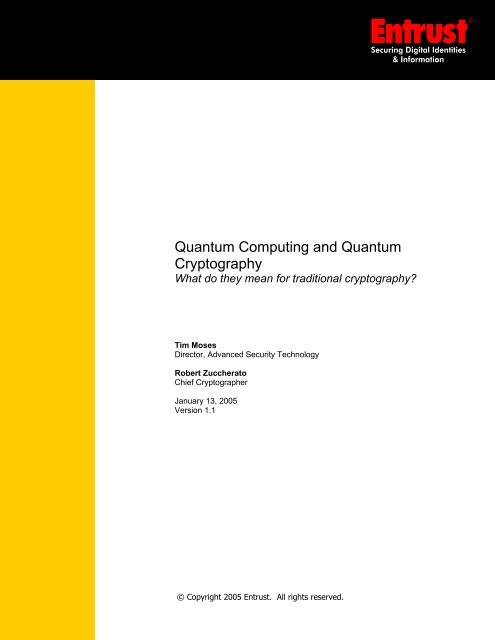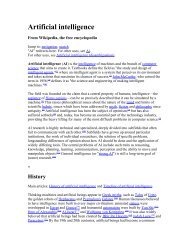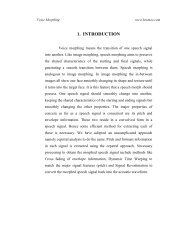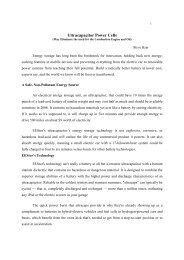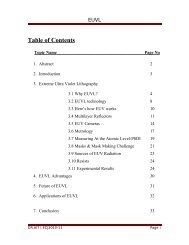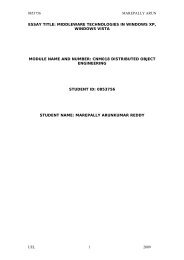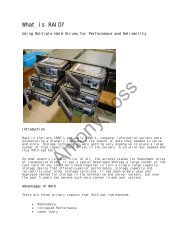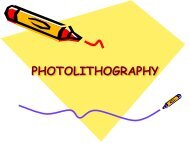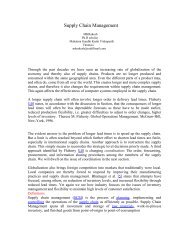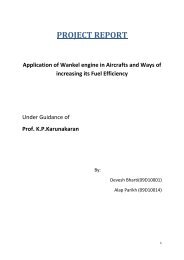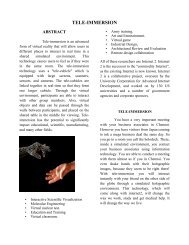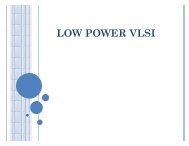Quantum Computing and Quantum Cryptography - Entrust
Quantum Computing and Quantum Cryptography - Entrust
Quantum Computing and Quantum Cryptography - Entrust
You also want an ePaper? Increase the reach of your titles
YUMPU automatically turns print PDFs into web optimized ePapers that Google loves.
<strong>Quantum</strong> <strong>Computing</strong> <strong>and</strong> <strong>Quantum</strong><br />
<strong>Cryptography</strong><br />
What do they mean for traditional cryptography?<br />
Tim Moses<br />
Director, Advanced Security Technology<br />
Robert Zuccherato<br />
Chief Cryptographer<br />
January 13, 2005<br />
Version 1.1<br />
© Copyright 2005 <strong>Entrust</strong>. All rights reserved.
<strong>Entrust</strong> is a registered trademark of <strong>Entrust</strong>, Inc. in the United States <strong>and</strong> certain<br />
other countries. <strong>Entrust</strong> is a registered trademark of <strong>Entrust</strong> Limited in Canada.<br />
All other <strong>Entrust</strong> product names <strong>and</strong> service names are trademarks or registered<br />
trademarks of <strong>Entrust</strong>, Inc or <strong>Entrust</strong> Limited. All other company <strong>and</strong> product<br />
names are trademarks or registered trademarks of their respective owners.<br />
© Copyright 2005 <strong>Entrust</strong>. All rights reserved.
<strong>Quantum</strong> <strong>Computing</strong> <strong>and</strong> <strong>Quantum</strong> <strong>Cryptography</strong><br />
Table of Contents<br />
1 Introduction ......................................................................................................................... 2<br />
1.1 Classical Physics <strong>and</strong> Computation....................................................................... 2<br />
2 <strong>Quantum</strong> Mechanics ........................................................................................................... 2<br />
3 <strong>Quantum</strong> <strong>Cryptography</strong>...................................................................................................... 4<br />
3.1 R<strong>and</strong>om Processes .................................................................................................. 4<br />
3.2 The Key Distribution Problem ................................................................................. 4<br />
3.3 The <strong>Quantum</strong> Solution ............................................................................................. 4<br />
3.4 <strong>Quantum</strong> vs. Public-Key <strong>Cryptography</strong>.................................................................. 6<br />
4 <strong>Quantum</strong> <strong>Computing</strong> .......................................................................................................... 7<br />
4.1 Realizing a <strong>Quantum</strong> Computer .............................................................................. 7<br />
4.2 Effect on Information Security Industry ................................................................. 8<br />
5 Conclusions......................................................................................................................... 9<br />
6 About <strong>Entrust</strong> ...................................................................................................................... 9<br />
© Copyright 2005 <strong>Entrust</strong>. All rights reserved.<br />
Page 1
<strong>Quantum</strong> <strong>Computing</strong> <strong>and</strong> <strong>Quantum</strong> <strong>Cryptography</strong><br />
1 Introduction<br />
Recently there has been a great deal of attention paid to the emerging <strong>and</strong> exciting areas of<br />
quantum computing <strong>and</strong> quantum cryptography. Media reports, in particular, have made the<br />
advances achieved in these areas sound particularly ominous. It is true that if quantum<br />
computing <strong>and</strong> quantum cryptography do reach their full potential, drastic changes to the state of<br />
computation in general <strong>and</strong> to the security l<strong>and</strong>scape <strong>and</strong> cryptography in particular will occur.<br />
However, it is difficult to determine from the hype <strong>and</strong> from the media reports what, exactly, these<br />
drastic changes will be <strong>and</strong> how likely they are to occur. This report attempts to provide some<br />
details <strong>and</strong> perspective on the topics of quantum computing <strong>and</strong> quantum cryptography <strong>and</strong> the<br />
effect they may have on the information security industry.<br />
1.1 Classical Physics <strong>and</strong> Computation<br />
More than 25 years ago Dr. Gordon E. Moore, the cofounder of Intel, made a prediction that<br />
eventually came to be known as Moore’s Law. He stated that the number of transistors on a<br />
microprocessor would double approximately every 18 months. This implies that the computing<br />
power of a modern computer will similarly double approximately every 18 months. This prediction<br />
has been (more or less) accurate throughout the 1970’s, 80’s <strong>and</strong> 90’s. For the near future, there<br />
seems to be no reason why the trend will not continue. However, if this trend continues for the<br />
next 15 or 20 years then transistors will become the size of atoms. What does this mean for the<br />
future of Moore’s Law?<br />
Right now, <strong>and</strong> in the foreseeable future, classical or Newtonian physics is sufficient to describe<br />
<strong>and</strong> to build a transistor. One need not be particularly concerned with the characteristics of<br />
particles at the subatomic level in order to build a modern computer. However, if Moore’s Law<br />
continues to hold <strong>and</strong> transistors become the size of atoms we can no longer ignore the effect of<br />
subatomic influences.<br />
Once we begin to deal with these subatomic influences, we will be using the area of physics<br />
known as quantum mechanics.<br />
2 <strong>Quantum</strong> Mechanics<br />
The scale of everyday experience extends from fractions of an inch to thous<strong>and</strong>s of miles. Years<br />
of living in this range of physical scales makes us feel that we underst<strong>and</strong> how objects at these<br />
scales will behave under most circumstances. Until as recently as a hundred years ago it was<br />
thought that our underst<strong>and</strong>ing of the everyday scale <strong>and</strong> of classical physics would enable us to<br />
underst<strong>and</strong> how things behave on a much larger <strong>and</strong> a much smaller scale. However, scientific<br />
developments in the twentieth century showed us that this was not the case. Einstein’s general<br />
theory of relativity, for instance, has shown us that, on the large scale, space-time is curved by<br />
the presence of mass. Our familiarity with the everyday scale did not prepare us for this<br />
conclusion. The same turns out to be true for scales much smaller than those encountered in<br />
everyday experience.<br />
One of the first hints of this was the so-called two-slit experiment. It was observed in 1927 by<br />
Clinton Davisson at Bell Labs that, when you place a barrier with a single slit in it between a<br />
source of electrons <strong>and</strong> a fluorescent screen, a single line is illuminated on the screen. When<br />
you place a barrier with two parallel slits in it between the source <strong>and</strong> the screen, the illumination<br />
takes on the form of a series of parallel lines fading in intensity the further away they are from the<br />
center. This is not surprising <strong>and</strong> is entirely consistent with a wave interpretation of electrons,<br />
© Copyright 2005 <strong>Entrust</strong>. All rights reserved.<br />
Page 2
<strong>Quantum</strong> <strong>Computing</strong> <strong>and</strong> <strong>Quantum</strong> <strong>Cryptography</strong><br />
which was the commonly held view at the time. However, Davisson discovered that when you<br />
turn down the intensity of the electron beam to the point where individual electrons can be<br />
observed striking the fluorescent screen, something entirely unexpected happens: the positions at<br />
which the electrons strike are points distributed r<strong>and</strong>omly with a probability matching the<br />
illumination pattern observed at higher intensity. It is as if each electron has physical extent so<br />
that it actually passed through both slits, but when it is observed striking the screen, it collapses<br />
to a point whose position is r<strong>and</strong>omly distributed according to a wave function. Waves <strong>and</strong><br />
particles are both familiar concepts at the everyday scale. But, at the sub-atomic level, objects<br />
appear to possess properties of both.<br />
This observation was one of the first to suggest that our classical theories were inadequate to<br />
explain events on the subatomic scale <strong>and</strong> that eventually gave rise to quantum theory. It has<br />
now been discovered that objects on an extremely small scale behave in a manner that is quite<br />
different from objects on an everyday scale, such as a tennis ball.<br />
Perhaps the most surprising observation is that objects on this very small scale, such as subatomic<br />
particles <strong>and</strong> photons, have properties that can be described by probability functions <strong>and</strong><br />
that they adopt concrete values only once they are observed. While the probability functions are<br />
entirely amenable to analysis, the concrete values they adopt when observed appear to be<br />
r<strong>and</strong>om. If you find this hard to believe, you are in good company. In fact, Niels Bohr once<br />
remarked that anyone who is not shocked by quantum theory has not understood it.<br />
Nevertheless, quantum theory has been called the most successful scientific theory ever<br />
developed because of the broad range of experimental observations with which it is consistent.<br />
One of the most dramatic illustrations of the probabilistic wave function representation of objects<br />
on the quantum scale is a thought experiment described by Erwin Schrödinger, <strong>and</strong> that is<br />
universally referred to as “Schrödinger’s cat”. We are asked to imagine a box containing a cat, a<br />
vial of cyanide, a radioactive source <strong>and</strong> a Geiger counter. The apparatus is arranged such that,<br />
if the Geiger counter detects the emission of an electron, then the vial is broken, the cyanide is<br />
released <strong>and</strong> the cat dies. According to quantum theory, the two states in which the electron has<br />
been emitted <strong>and</strong> the electron has not been emitted exist simultaneously. So, the two states: cat<br />
dies <strong>and</strong> cat lives, exist simultaneously until the box is opened <strong>and</strong> the fate of the cat is<br />
determined. To the best of our knowledge, no one has actually attempted to perform this<br />
experiment. But, if they were to, we can be confident that their observations would be entirely<br />
consistent with this theory.<br />
What we should take from this thought experiment is that quantum objects adopt multiple states<br />
simultaneously, in a process called superposition, <strong>and</strong> that they collapse to a single r<strong>and</strong>om state<br />
only when they are observed.<br />
Thus, we have two options when deciding how to deal with the subatomic influences of quantum<br />
mechanics, such as the probabilistic properties of these objects <strong>and</strong> the process of superposition.<br />
We can either merely deal with them in an attempt to build even smaller classical computers <strong>and</strong><br />
hopefully extend the period of applicability of Moore’s Law, or we can use these properties to our<br />
advantage <strong>and</strong> go beyond what traditional computation provides. Not surprisingly, many people<br />
are attempting to do the latter. Also not surprisingly, when they do, completely new models of<br />
computation arise.<br />
© Copyright 2005 <strong>Entrust</strong>. All rights reserved.<br />
Page 3
<strong>Quantum</strong> <strong>Computing</strong> <strong>and</strong> <strong>Quantum</strong> <strong>Cryptography</strong><br />
3 <strong>Quantum</strong> <strong>Cryptography</strong><br />
3.1 R<strong>and</strong>om Processes<br />
Many of the processes that we commonly think of as r<strong>and</strong>om are not truly r<strong>and</strong>om: we merely<br />
lack the data or computing power to predict future values. For instance, if we had sufficient<br />
information about a piece of buttered toast falling towards a carpeted floor we would be able to<br />
predict whether it will l<strong>and</strong> butter-side down. <strong>Quantum</strong> processes on the other h<strong>and</strong> are truly<br />
r<strong>and</strong>om. No amount of computing power will enable us to make predictions about their future<br />
values.<br />
R<strong>and</strong>om processes, such as those exhibited by quantum processes are of enormous interest in<br />
cryptography. All cryptography uses keys to protect either the confidentiality or integrity of data.<br />
These keys must be unpredictable to an attacker <strong>and</strong> thus are usually produced by a R<strong>and</strong>om<br />
Number Generator (RNG) which uses some r<strong>and</strong>om process to generate the cryptographic key.<br />
Since we typically just lack the computing power required to predict the outcome of these<br />
processes, we usually obtain a level of computational security, rather than absolute security. In<br />
other words, the attacker is limited only by the lack of computing power to determine the outcome<br />
of the r<strong>and</strong>om process. (In practice, this does not imply a vulnerability in modern cryptography as<br />
the amount of computing power required can be made arbitrarily large.) A truly r<strong>and</strong>om process<br />
would provide keys that could not be determined, regardless of the amount of computing power<br />
available. As we saw earlier, quantum processes have this property. Hence, researchers search<br />
for a way to apply quantum mechanics to cryptography.<br />
3.2 The Key Distribution Problem<br />
In particular, quantum mechanics can be used to help solve the key distribution problem, which is<br />
encountered by any two entities that wish to communicate using a cryptographically protected<br />
channel. If Alice <strong>and</strong> Bob want to use a traditional block cipher <strong>and</strong> message authentication code<br />
to protect their communications, they need to agree upon a shared key to use. This problem is<br />
currently solved using public-key cryptography. Alice <strong>and</strong> Bob each generate a public-private key<br />
pair <strong>and</strong> register their public key with a Certification Authority (CA). The CA then creates a<br />
certificate for each of them <strong>and</strong> distributes the certificate to the other party. Alice <strong>and</strong> Bob can<br />
now use their private keys <strong>and</strong> the public key contained in each other’s certificate to agree upon a<br />
shared symmetric key to be used in the block cipher or message authentication code. A number<br />
of specific algorithms <strong>and</strong> protocols exist for doing this. These include Diffie-Hellman key<br />
agreement, RSA key transport, etc.<br />
Public-key cryptography is currently secure. Using key sizes currently in use, it appears<br />
infeasible for any attacker to be able to obtain a user’s private key solely from his/her public key,<br />
which is what would typically be required to break these schemes. However, in theory, if<br />
sufficient computing power existed or if a solution is found to the mathematical problem upon<br />
which the algorithm is based, then these schemes could be vulnerable to attack. There is no<br />
reason to believe that either of these outcomes is likely. However, since the security provided is<br />
computational, rather than absolute, some are searching for alternative approaches.<br />
3.3 The <strong>Quantum</strong> Solution<br />
<strong>Quantum</strong> cryptography provides a different solution to the key distribution problem. Like publickey<br />
cryptography, it allows Alice <strong>and</strong> Bob to securely agree upon a key over an insecure channel.<br />
The key can then be used in a conventional symmetric cipher, message authentication code or<br />
one-time-pad. It is worth pointing out at this point that quantum cryptography is not a new cipher<br />
<strong>and</strong> it does not obsolete symmetric-key cryptography or many uses of public-key cryptography.<br />
© Copyright 2005 <strong>Entrust</strong>. All rights reserved.<br />
Page 4
<strong>Quantum</strong> <strong>Computing</strong> <strong>and</strong> <strong>Quantum</strong> <strong>Cryptography</strong><br />
<strong>Quantum</strong> cryptography allows a key distribution scheme that provides absolute security. We<br />
know that it provides absolute security because, unlike traditional cryptographic schemes that are<br />
based upon hard mathematical problems, this scheme is based upon one of the laws of physics<br />
known as the Heisenberg Uncertainty Principle. This principle states that it is impossible to know<br />
both the position <strong>and</strong> momentum (or speed) of a particle with arbitrary precision. Thus, the more<br />
precisely you know a particle’s position the more uncertainty you have about its momentum <strong>and</strong><br />
vice versa. This law can also be generalized to cover other pairs of properties such as energy<br />
<strong>and</strong> time, horizontal <strong>and</strong> vertical polarizations, etc. Each of these pairs of properties are known<br />
as conjugate variables <strong>and</strong> each has the property that the more precisely you know one of the<br />
properties, the less information you have regarding the other.<br />
Before looking at how quantum cryptography actually works let’s first consider a scenario that is<br />
very similar. Let’s say Alice wants to agree upon a 1 bit value with Bob. If she wants to<br />
exchange a longer value, she can do it by repeating this one procedure the required number of<br />
times. Now, we will give Alice a box with two compartments. Alice will put a coin in both of the<br />
compartments. These compartments are constructed in such a way that they can be opened<br />
individually, but when one compartment is opened the floor of the other compartment jumps so as<br />
to cause the coin in the other compartment to flip <strong>and</strong> to l<strong>and</strong> r<strong>and</strong>omly on either heads or tails.<br />
Only one compartment can be opened at a time.<br />
In order to send this bit value to Bob she will put a coin in one of the compartments with the side<br />
facing up corresponding to the value she wishes to send. She then puts another coin in the other<br />
compartment with a r<strong>and</strong>om side facing up. Now, if Bob knows which compartment she put the<br />
coin in, he can open that compartment <strong>and</strong> determine the value. However, if he opens the wrong<br />
compartment he will simply obtain a r<strong>and</strong>om value <strong>and</strong> the value that Alice intended to send to<br />
him will be lost forever. Similarly, an attacker that doesn’t know which compartment to open will<br />
have a 50-50 chance of opening the wrong compartment <strong>and</strong> getting a r<strong>and</strong>om value. If the<br />
attacker then passes the box along to Bob after having looked in one of the compartments, there<br />
is a 50-50 chance that she will have changed the value being exchanged to a completely r<strong>and</strong>om<br />
value <strong>and</strong> thus will have introduced an error.<br />
After Alice sends the box (or multiple boxes) a number of times, she <strong>and</strong> Bob need merely to<br />
compare the compartment in which she placed the coin with the one that Bob opened for each<br />
trial, <strong>and</strong> discard those trials for which no match occurred. Even if an attacker eavesdropped on<br />
this conversation, the odds are against her making the same choices as Bob for all trials <strong>and</strong> so<br />
there will likely be error in the agreed upon bits. Alice <strong>and</strong> Bob can compare some subset of the<br />
agreed upon bits to determine if errors occurred <strong>and</strong> the attacker will likely be discovered.<br />
<strong>Quantum</strong> cryptography works similar to this, but uses conjugate variables instead of boxes<br />
holding coins. For Alice <strong>and</strong> Bob to agree upon a cryptographic key Alice will first encode a bit of<br />
the key into one of a pair of conjugate variables. Usually this will be the horizontal <strong>and</strong> vertical<br />
polarizations of a photon. She repeats this for each bit, r<strong>and</strong>omly choosing the horizontal or<br />
vertical polarization. She transmits each of these photons to Bob, who then r<strong>and</strong>omly chooses to<br />
measure either the horizontal or vertical polarization. If he chooses the correct polarization to<br />
measure, then he can decode the bit, otherwise he obtains a completely r<strong>and</strong>om (<strong>and</strong> useless)<br />
value, just as if he had opened the wrong compartment. Alice <strong>and</strong> Bob can now make public<br />
which polarization (but not the encoded bit value!) they were measuring <strong>and</strong> agree to use only<br />
those bits corresponding to the positions in which they agreed on the polarization to measure.<br />
An attacker could also attempt to measure the polarizations <strong>and</strong> decode the bit values. However,<br />
like Bob initially, she will not know which property Alice used <strong>and</strong> thus, which property to<br />
measure. Again, by the Heisenberg Uncertainty Principle, our attacker will not be able to<br />
measure those polarizations that she guesses incorrectly <strong>and</strong> thus will necessarily introduce<br />
errors into the exchanged key stream, just as if she had opened the wrong compartment of our<br />
© Copyright 2005 <strong>Entrust</strong>. All rights reserved.<br />
Page 5
<strong>Quantum</strong> <strong>Computing</strong> <strong>and</strong> <strong>Quantum</strong> <strong>Cryptography</strong><br />
fictitious box. Alice <strong>and</strong> Bob can detect these errors by publicly exchanging some number of the<br />
exchanged bits <strong>and</strong> rejecting the key stream if a significant number of errors occur. Thus,<br />
according to the laws of physics our attacker will be thwarted.<br />
3.4 <strong>Quantum</strong> vs. Public-Key <strong>Cryptography</strong><br />
We note that quantum cryptography is possible now. It has been implemented <strong>and</strong> keys have<br />
been exchanged over distances of greater than 100 km. Key agreement is possible at rates of<br />
about 2 kilobits per second. There are companies that are currently selling devices that perform<br />
quantum key distribution.<br />
The story behind quantum cryptography is very attractive. However, there are a few details that<br />
we should keep in mind that limit its potential use. To begin with notice that in order for Alice <strong>and</strong><br />
Bob to agree upon the property that was measured or to detect errors introduced by an attacker,<br />
they need to communicate over an authentic channel. Confidentiality is not required as no<br />
security is lost if our attacker can see these communications. However, they need to be sure that<br />
the attacker is not modifying the communications <strong>and</strong> thus hiding her activities. Typically, an<br />
authentic channel is obtained by the two parties sharing a cryptographic key which can be used<br />
as part of a cryptographic integrity mechanism. Thus, Alice <strong>and</strong> Bob will usually need to have<br />
some previously shared information in order to use quantum cryptography to agree upon a key.<br />
This is actually not substantially better than the current situation of agreeing upon keys using<br />
public-key cryptography.<br />
It is also worth pointing out that currently in order for Alice to transmit the photon to Bob, both<br />
Alice <strong>and</strong> Bob must be online <strong>and</strong> they must have an unbroken, continuous communications<br />
channel (e.g., an unbroken, continuous optical fibre) between them. Research is being<br />
conducted that may allow us to build a quantum router in the future. This would allow quantum<br />
cryptography to be used on a network. However, at this time, an unbroken communications<br />
channel is required. Currently there is no way to store the photon for measurement at a later<br />
time. Also, Alice <strong>and</strong> Bob must communicate (to agree upon the property <strong>and</strong> for error detection)<br />
after transmission <strong>and</strong> reception of the photon, but before the key is used. Thus, quantum<br />
cryptography does not lend itself to many common uses of cryptography, in particular store-<strong>and</strong>forward<br />
encryption (as is used in file encryption or secure email) <strong>and</strong> situations where there may<br />
be many intermediaries (as in the Internet). We note again however that research is continuing in<br />
order to overcome this problem.<br />
We also note that quantum cryptography does not, currently, provide a satisfactory method of<br />
obtaining a digital signature. Digital signatures, <strong>and</strong> the integrity <strong>and</strong> authenticity protection that<br />
they provide, are one of the most popular uses of public-key cryptography. Currently proposed<br />
quantum digital signature schemes only allow signature verification by a small number of people<br />
or have other impracticalities. Since one of the most useful properties of traditional digital<br />
signatures is their ability to be verified by anyone (for example, on the web), it is unlikely that<br />
quantum digital signatures as currently envisioned will be sufficient. Thus, it is likely that most<br />
organizations will still require a PKI in order to provide support for these critical digital signatures.<br />
Thus, quantum cryptography does not appear to be practical except in very unique situations. It<br />
may become practical to be used between two fixed parties with a substantial amount of data to<br />
exchange, <strong>and</strong> very high confidentiality requirements. For example, it may find application in<br />
securing metropolitan area data links. In fact, it is rumoured that some intelligence organizations<br />
have such systems in place to connect computers in different districts of the same city. However,<br />
despite all of its promise, for most common uses of cryptography, it is not likely to replace current<br />
practice in the foreseeable future.<br />
© Copyright 2005 <strong>Entrust</strong>. All rights reserved.<br />
Page 6
<strong>Quantum</strong> <strong>Computing</strong> <strong>and</strong> <strong>Quantum</strong> <strong>Cryptography</strong><br />
4 <strong>Quantum</strong> <strong>Computing</strong><br />
4.1 Realizing a <strong>Quantum</strong> Computer<br />
<strong>Quantum</strong> computing is a powerful new model of computation that takes advantage of the strange<br />
<strong>and</strong> wonderful properties of quantum objects. In doing so, it allows much more difficult problems<br />
to be solved than classical computing models. The power comes from the superposition<br />
property, which we can think of as allowing us to operate upon all possible n bit combinations at<br />
once.<br />
In traditional, classical computing models, the basic unit of information is a “bit”. A bit can have<br />
one of two states. It can be either a 0 or a 1. We can then construct certain operations, or gates,<br />
which take some number of bits as input <strong>and</strong> produce a bit as output. These gates can be<br />
combined into a circuit to produce a desired result. In a nutshell, this is how modern computers<br />
are built <strong>and</strong> programmed to solve problems of interest to us. For any given circuit we can<br />
consider the number of gates that are required <strong>and</strong> compare this measure to the number of gates<br />
required by any other circuit. This metric provides us with one measure of complexity of solving<br />
the given problem.<br />
Similarly, in the quantum computing model we have a basic unit of information called the<br />
“quantum bit” or “qubit”. A qubit can be represented by what physicists call an “ideal two-state<br />
quantum system.” Examples of these systems include photons (vertical <strong>and</strong> horizontal<br />
polarization), electrons <strong>and</strong> other spin-1/2 systems (spin up <strong>and</strong> down) <strong>and</strong> systems defined by<br />
two energy levels of atoms or ions. Each qubit has two “logical” or “computational” states. These<br />
states correspond to the traditional 0 <strong>and</strong> 1 bit values with which we are familiar.<br />
Qubits can also take on values that are superpositions of the logical states. Thus, they can be<br />
thought of as having a state that is a combination of both a 0 state <strong>and</strong> a 1 state. These<br />
superpositions can actually be physically realized by a qubit in a quantum computer. As with<br />
classical bits, we can also build gates that act upon these qubits <strong>and</strong> produce as output qubits<br />
that are also superpositions. We can then combine these gates into circuits to solve problems of<br />
interest to us. Since these gates are now working on superpositions of the logical states, we can<br />
think of them as operating on all possible combinations of the bits at once.<br />
For example, with a string of three classical bits we have eight possible values (000, 001, 010,<br />
011, 100, 101, 110, 111). Any gate can only act upon one of these eight values at once. Thus, if<br />
we want to process all eight possible values, the gate must act on them one at a time. However,<br />
a string of 3 qubits can be a superposition of all eight possible logical values <strong>and</strong> thus a quantum<br />
gate that acts upon such a qubit can effectively process all eight values simultaneously.<br />
Of course, we experience the universe only in a classical way <strong>and</strong> thus we must somehow<br />
transform these qubits into classical bits that have meaning to us <strong>and</strong> that we can process.<br />
Fortunately, qubits can be measured. As we mentioned in Section 2, when quantum objects are<br />
measured they take on concrete values, in this case classical bits, with a probability distribution<br />
corresponding to the nature of the superposition in which they exist.<br />
<strong>Quantum</strong> computers containing 7 qubits have been built <strong>and</strong> are thus more than just the dream of<br />
some theoretical physicists. However, many experts predict that we are likely 15-20 years away<br />
from building computers that are large enough to be able to solve practical <strong>and</strong> interesting<br />
problems.<br />
© Copyright 2005 <strong>Entrust</strong>. All rights reserved.<br />
Page 7
<strong>Quantum</strong> <strong>Computing</strong> <strong>and</strong> <strong>Quantum</strong> <strong>Cryptography</strong><br />
4.2 Effect on Information Security Industry<br />
Should practical quantum computers ever be built, there will be at least two important lasting<br />
effects for the information security industry to deal with. <strong>Quantum</strong> computers have the potential<br />
to drastically effect the security provided by both symmetric-key algorithms (e.g., block ciphers)<br />
<strong>and</strong> public-key algorithms (e.g., RSA), although the magnitude of the effect will be different.<br />
Currently if we are given a strong block cipher with an N-bit key that we wish to attack, 2 N<br />
classical operations are required to be certain of finding the key. This is accomplished by<br />
searching through all 2 N possible keys <strong>and</strong> trying each one. When one of these keys successfully<br />
decrypts the ciphertext, we know that we have found the right one. So, for example, CAST-128<br />
uses a 128-bit key <strong>and</strong> requires 2 128 operations in order to attack it <strong>and</strong> recover the key. Keys of<br />
this size provide very strong security <strong>and</strong> most cryptographers believe that they should be secure<br />
for at least 30 years.<br />
<strong>Quantum</strong> computers, however, permit an algorithm (called “unstructured quantum search”) that<br />
can break a symmetric cipher substantially faster than classical algorithms. Unstructured<br />
quantum search can find the key in 2 N/2 operations. Using our example from above, CAST-128<br />
would require 2 64 operations in order to recover the key. This provides very low security. It is<br />
possible today to run attacks that require 2 64 operations. Note, however, that AES-256 would still<br />
require 2 128 operations to attack <strong>and</strong> to find any particular key. Since 2 128 operations is<br />
considered infeasible, we could simply increase key sizes by switching to AES-256 (or similar<br />
ciphers with a long key size) <strong>and</strong> still obtain the same level of security enjoyed today.<br />
The situation for public-key cryptography is bleaker. <strong>Quantum</strong> computers permit algorithms that<br />
will break public-key systems in trivial amounts of time. A quantum algorithm exists (called<br />
“quantum order finding”) for breaking RSA. This is the most widely used public-key algorithm for<br />
both encryption <strong>and</strong> digital signatures. Similar algorithms also exist for all commonly used publickey<br />
algorithms like DSA, Diffie-Hellman, <strong>and</strong> ECC. The point is that if quantum computers can be<br />
built, these problems can be solved easily. It is estimated that 1024-bit RSA key could be broken<br />
with 3000 qubits <strong>and</strong> 100,000,000 gates. <strong>Quantum</strong> computers of this size may be available<br />
within the next 20-30 years. Remember however that the current largest quantum computer only<br />
has 7 qubits! Thus, this is not an immediate concern, <strong>and</strong> won’t be for quite a number of years.<br />
However, we should start thinking about a very long term future with radically different<br />
cryptography. Fortunately, alternatives do exist. Many of the public-key systems based upon the<br />
lattice reduction problem appear to resist quantum attacks. Ralph Merkle, in some of his<br />
pioneering work on public-key cryptography, has also developed algorithms that appear to still be<br />
secure in a quantum computational model. These include his puzzle scheme for key agreement<br />
<strong>and</strong> his one-time signature scheme that uses just hash functions to create signatures.<br />
Unfortunately, none of these options has been the subject of enough practical research to be<br />
securely implemented in a useful manner at this time. Given the long timeframe that quantum<br />
computers appear to provide though, these, <strong>and</strong> other, algorithms may be ready for prime-time<br />
before current methods are rendered insecure.<br />
We also note that quantum cryptography is another key distribution method that would be<br />
immune from quantum computing attacks, for those environments in which quantum cryptography<br />
is relevant. This is because quantum cryptography provides a level of absolute security <strong>and</strong><br />
regardless of the amount of computing power available, the laws of physics say that it is<br />
impossible to break since it is impossible to measure the value of both of a pair of conjugate<br />
variables. Note however, that if a public- or symmetric-key mechanism is used to protect the<br />
authentic channel that Alice <strong>and</strong> Bob must communicate over, then the security of this channel<br />
would be affected by the development of a quantum computer.<br />
© Copyright 2005 <strong>Entrust</strong>. All rights reserved.<br />
Page 8
<strong>Quantum</strong> <strong>Computing</strong> <strong>and</strong> <strong>Quantum</strong> <strong>Cryptography</strong><br />
5 Conclusions<br />
<strong>Quantum</strong> cryptography may find application in certain specific applications. For example, in<br />
securing metropolitan area data links. However, the constraints upon its use do not make it a<br />
practical solution for many popular uses of cryptography at this time. However, if research into<br />
quantum routers <strong>and</strong> quantum digital signatures bear fruit, then this situation might change. It will<br />
likely be at least 5 to 10 years before quantum cryptography can become practical. Even then, it<br />
is not clear that the marginal improvement in security will be worth the cost.<br />
<strong>Quantum</strong> computing (if it were to become practical) will change our world out of all recognition.<br />
Symmetric ciphers (e.g. AES <strong>and</strong> CAST) will be weakened. But, we simply have to increase key<br />
sizes to restore the necessary level of security. Asymmetric ciphers (all the ones in common use,<br />
such as ECC, Diffie-Hellman, DSA, RSA) will be rendered insecure. <strong>Cryptography</strong> researchers<br />
have some ideas about how to make asymmetric ciphers that are not vulnerable, but nothing<br />
amenable to engineering at this time.<br />
Fortunately, quantum computers aren't going to be practical any time soon. People have built 7-<br />
qubit machines. When there are machines with thous<strong>and</strong>s of qubits, the kinds of development<br />
mentioned earlier will become practical. It is unlikely that a 3000 qubit quantum computer will be<br />
suddenly built without substantial warning. Developments like this are typically achieved by a<br />
slow gradual process. Experts currently talk about the 20-year timeframe before these<br />
developments occur. Because of this, we expect that there will be plenty of time for users of<br />
classical cryptographic techniques to transition to new schemes resisting quantum attacks in<br />
plenty of time before implemented keys become vulnerable, if required. Thus, for the time-being,<br />
<strong>Entrust</strong> is aware of <strong>and</strong> actively reviewing current developments. We thoroughly expect that the<br />
necessary cryptographic developments will be achieved in the required timeframe.<br />
6 About <strong>Entrust</strong><br />
<strong>Entrust</strong>, Inc. [Nasdaq: ENTU] is a world leader in securing digital identities <strong>and</strong> information,<br />
enabling businesses <strong>and</strong> governments to transform the way they conduct online transactions <strong>and</strong><br />
manage relationships with customers, partners <strong>and</strong> employees. <strong>Entrust</strong>'s solutions promote a<br />
proactive approach to security that provides accountability <strong>and</strong> privacy to online transactions <strong>and</strong><br />
information. Over 1,200 enterprises <strong>and</strong> government agencies in more than 50 countries use<br />
<strong>Entrust</strong>'s portfolio of security software solutions that integrate into the broad range of applications<br />
organizations use today to leverage the Internet <strong>and</strong> enterprise networks. For more information,<br />
please visit http://www.entrust.com<br />
© Copyright 2005 <strong>Entrust</strong>. All rights reserved.<br />
Page 9


